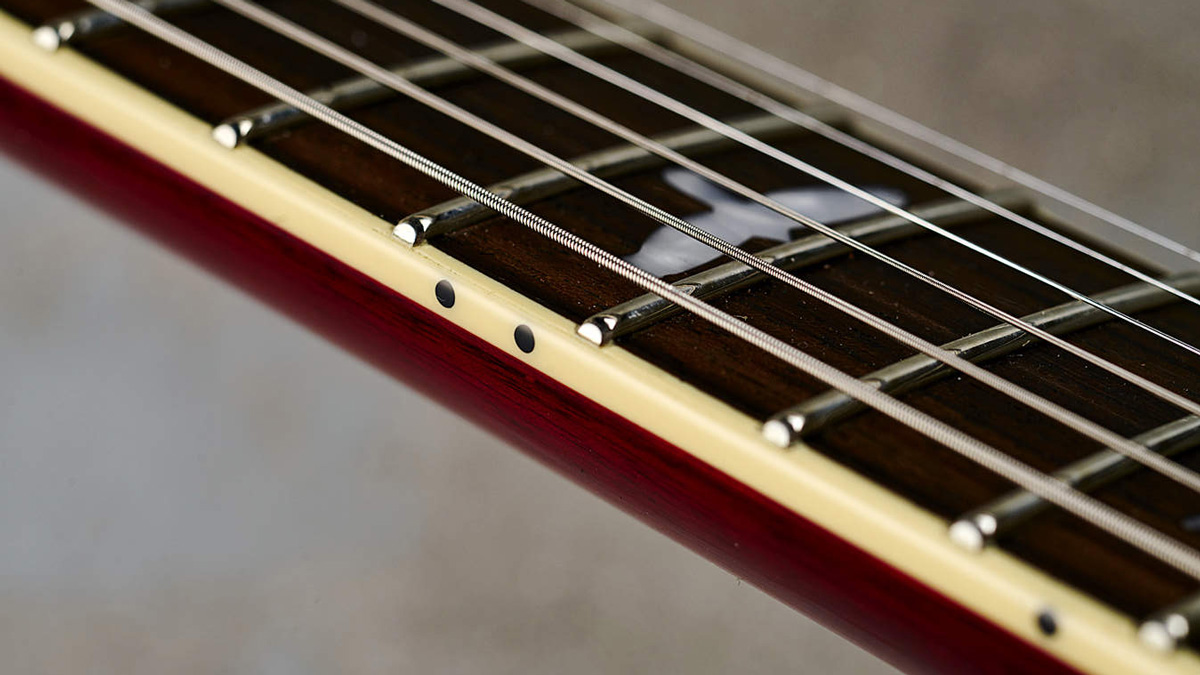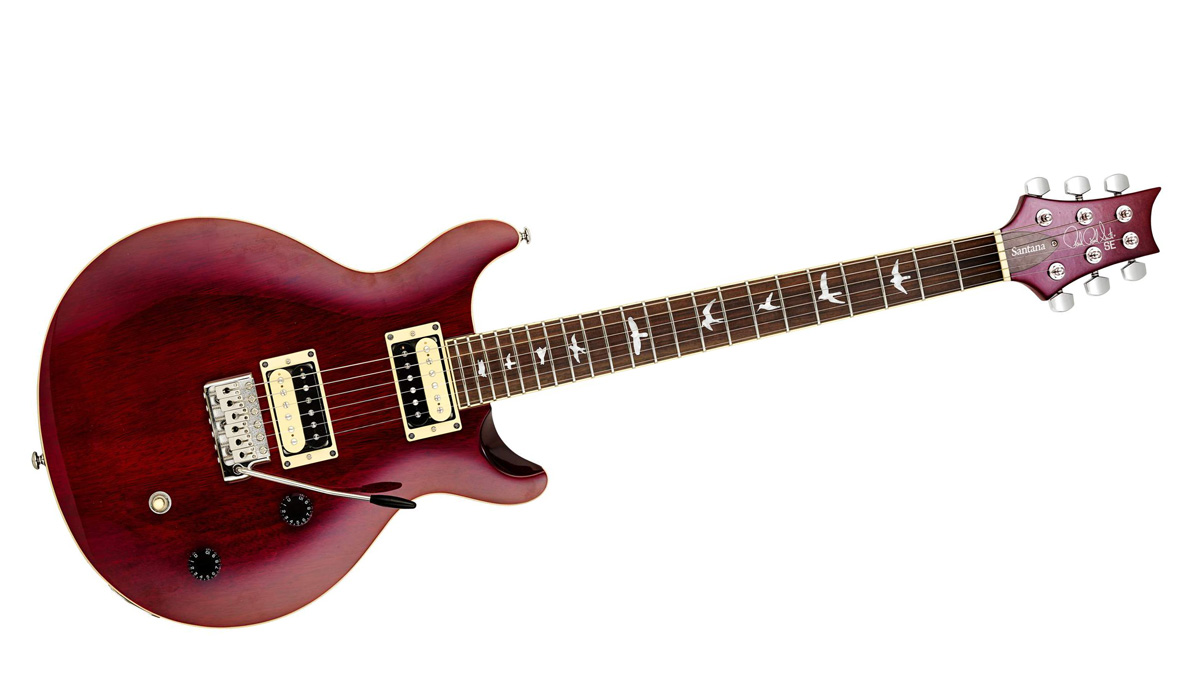MusicRadar Verdict
This guitar will not only get you on the PRS ladder, but for existing PRS fans it’s a good knockabout guitar that won’t make you blub inconsolably when they get dinged in action.
Pros
- +
Price, build quality, girthsome sounds, excellent playability and modding potential.
Cons
- -
Aside from colour choice and you’ll need a gigbag, nothing.
MusicRadar's got your back
The term ‘Standard’ might be applied to the most coveted glued-neck guitar there is but in traditional PRS lexicography, ‘Standard’ means without a maple top to differentiate it from the Custom.
Today, while there are no Standards in the USA Core lineup, they form a major part of the more rock ’n’ roll S2 line where these all-mahogany guitars are also ID’d by classic dot inlays rather than the trademark PRS birds. As we move further down the price scale the offshore-made SE line has a trio of Standards (245, Standard 24, and Standard 24 Multi-Foil) plus this new signature model, the 2018 Santana. And with the exception of that Multi-Foil model, the big difference is the price, having been made in Indonesia, as opposed to Korea.
The new Santana Standard isn’t outwardly a simpler version of the SE Santana. Yes, it doesn’t have the figured maple veneer over solid maple top; it’s spec’d simply as mahogany but through the quite classic see-thru Cherry gloss finish you can clearly see that top and back aren’t from the same piece, or even the same tree. The top appears to be one-piece of rather classic-looking mahogany with its small grain flecks; the back is three pieces of a much more striped wood; and the neck is a longitudinal laminate of three pieces, excluding the headstock widening wings.
Sure, the non-standard SE Santana has a three-piece back of off-centre joined pieces but in its natural gloss it does look like mahogany; the neck is one-piece (excluding those headstock wings) and has a diagonal grain viewed from the top of the head.

And while the more expensive guitar is binding free - the top’s edge is natural as you’d expect - this Standard version has cream binding around the top edge and the fingerboard, moving it further still away from the classic PRS recipe.
It employs rosewood fingerboard that appears lighter and more striped than the non-Standard models. Another change is the 22 frets of the Standard as opposed to the 24 of the existing SE Santana (both have a ‘short’ 622mm/24.5-inch scale length), like his originals, while bird inlays on both are milky pearloid. Less obviously, another difference is the fret wire; they share a 2.7mm width but those on the Standards are considerably higher - there’s also a different cream coloured nut material.
Hardware appears identical across both our Standard models and the more expensive signatures. The tuners are non-locking and quite generic looking, while the vibratos are in fact the same are those used on the USA S2 line. The top plate (steel) is cast, not machined like the Core vibratos; the block is steel, not brass; and the saddles appear to be sintered (powdered metal), giving a texture to the nickel plating. The arm is push fit as usual and tension-adjustable by a small grub screw - the arm isn’t stainless steel and is a slightly smaller diameter than the USA Core spec. Rather oddly, the Standards have three vibrato springs, the non-Standard models, four.
Want all the hottest music and gear news, reviews, deals, features and more, direct to your inbox? Sign up here.
The Santana Standard also places its controls in typical PRS style; the non-Standard Santana reverts to original style with its distant and quite closely spaced master volume and tone. Internally there is little surprise, with a treble bleed capacitor on the volume, plus both zebra humbuckers have four-conductor wiring should you want to add your own coil-splits.
Sounds
Whether or not it’s the pre-production shape, the lack of figured maple or indeed the added binding, this Santana Standard just doesn’t really look or feel like a PRS. The neck is spec’d with a ‘wide fat’ profile but it feels more generic, lacking both the fuller depth and slightly V’d shape in its lower positions. It’s not bad, just slightly different.
Plug it in after the non-Standard SE Santana and the sounds are certainly a lot closer than you might expect from the slightly different construction. While it might not nail the depth, sonic detail and fatter voice of the USA Core model, there’s plenty of rock kick from the bridge contrasted by a nicely vintage-y neck humbucker that really captures a vocal PRS voice.
If you were to add coil-splits here you’d have an extremely versatile guitar that spans classic rock to metal with surprising soul and blues from that neck pickup. We certainly prefer the control placement here as opposed to the non-Standard model and the tone is nicely graduated to pull down the highs a little from the bridge, especially with a bright-edged Marshall-y amp voice. Ultimately it’s a great little guitar.
Despite the near £300 price difference, this Standard holds up extremely well to its non-Standard stablemates. The Santana Standard has a lovely resonance and sustain that rises very fast from the attack: with too many guitars in this price point you’ll hear a lot of bright attack that isn’t followed with quite so full a rise.
For a company that, from its inception, has been constantly criticised for the price of its instruments, this Standard almost feels like an impulse buy. With no gigbag and limited finishes we’re hardly spoilt for choice but while you might have expected a ‘cheaper’ unbound satin finish with dot inlay specification, there’s very little to actually differentiate in feel or sound between this and the non-Standard signature. If it feels perhaps a little more generic that’s hardly surprising, but once again it’s build quality that PRS is flagging up here.
This guitar will not only get you on the PRS ladder, but for existing PRS fans it’s a good knockabout guitar that won’t make you blub inconsolably when it gets dinged in action.
Dave Burrluck is one of the world’s most experienced guitar journalists, who started writing back in the '80s for International Musician and Recording World, co-founded The Guitar Magazine and has been the Gear Reviews Editor of Guitarist magazine for the past two decades. Along the way, Dave has been the sole author of The PRS Guitar Book and The Player's Guide to Guitar Maintenance as well as contributing to numerous other books on the electric guitar. Dave is an active gigging and recording musician and still finds time to make, repair and mod guitars, not least for Guitarist’s The Mod Squad.

